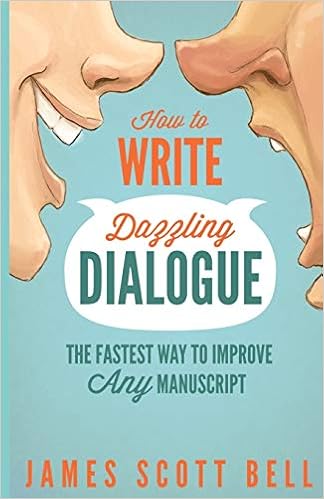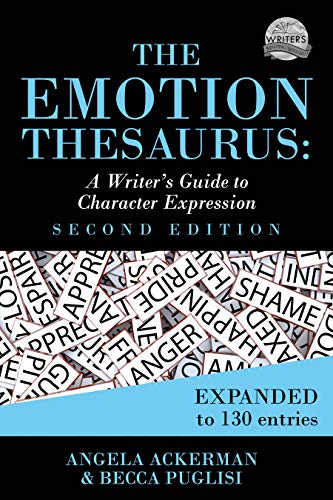Bookshelf of Specialized Writing Topics
Description & Setting: Techniques and Exercises for Crafting a Believable World of People, Places, and Events (Write Great Fiction)
This is part of Ron Ronzelle’s quality series of writing. I don’t have this one, but I have several others. I’m sure it is really good!
“Build a Believable World
How essential is setting to a story? How much description is too much? In what ways do details and setting tie into plot and character development? How can you use setting and description to add depth to your story?
You can find all the answers you need in Write Great Fiction: Description & Setting by author and instructor Ron Rozelle. This nuts-and-bolts guide – complete with practical exercises at the end of each chapter – gives you all the tips and techniques you need to:
- Establish a realistic sense of time and place
- Use description and setting to drive your story
- Craft effective description and setting for different genres
- Skillfully master showing vs. telling
With dozens of excerpts from some of today’s most popular writers, Write Great Fiction: Description & Setting gives you all the information you need to create a sharp and believable world of people, places, events, and actions.”
The Only World Building Workbook You’ll Ever Need: Your New Setting Bible (Series Bibles for Writers)
This is a part of the “Series Bible for Writers” and this book will get your creative juices flowing!
Become a master of unforgettable worlds. For novelists, game developers, producers, script writers, and even history buffs. In this second installment of Series Bibles for Writers, discover the intricate world of your stories. Whether you’re writing fantasy, science fiction, alternate reality, dystopian, romance, time travel, historical, or even contemporary, understanding the world your characters live in is vital to giving readers a genuine, immersive experience.
30 Days of Worldbuilding: An Author’s Step-by-Step Guide to Building Fictional Worlds (Author Guides)
If you’re a workbook person, this is a very helpful one! Provides very good ‘think sheets’
“30 Days of Worldbuilding breaks the task into manageable chunks. By following 30 creative prompts, this book will guide you from idea, to full world.
This book also includes a bonus lesson on building magic systems that work.
By completing just one prompt each day, you can have a fully created fantasy world in a month. You will also have an invaluable book of worldbuilding notes to keep beside you as you write.
Get 30 Days of Worldbuilding today, and stop getting lost in your world.”
How to Write Dazzling Dialogue: The Fastest Way to Improve Any Manuscript
I have recommended many James Scott Bell books and this one is no exception. It’s very helpful if you’re in the polishing stage!
“There is one sure-fire way of improving your novel fast. . .
You may know the fundamentals of how to write fiction. You may be more than competent in plot, structure and characters. But if your dialogue is dull it will drag the whole story down.
On the other hand, if your dialogue is crisp and full of tension it immediately grabs the reader. And if that reader is an agent or editor, sharp dialogue will give them instant assurance that you know what you’re doing as a writer.
Writing a bestseller or hot screenplay is no easy task, but dazzling dialogue is an absolute essential if you want to get there. The best part is, the skills of the dialogue craft are easy to understand and put into practice. #1 bestselling writing coach James Scott Bell has put together and expanded upon the dialogue lectures from his popular writing seminars.”
Crafting Dynamic Dialogue: The Complete Guide to Speaking, Conversing, Arguing, and Thinking in Fiction (Creative Writing Essentials)
I always like to give you options! Here’s another great book on dialogue.
“Exceptional dialogue isn’t just important when writing fiction–it’s essential. In order to impress an agent or editor and keep readers turning pages, you need to deliver truly standout dialogue in every scene. Crafting Dynamic Dialogue will give you the techniques and examples you need to impress your readers.
This book is a comprehensive guide to writing compelling dialogue that rings true. Each section is packed with advice and instruction from best-selling authors and instructors like Nancy Kress, Elizabeth Sims, Steven James, Deborah Halverson, James Scott Bell, Donald Maass, Cheryl St. John, and many others.”
The Emotion Thesaurus: A Writer’s Guide to Character Expression (Second Edition) (Writers Helping Writers Series Book 1)
This book is so helpful –it’s almost like cheating! It’s a must for every author’s library!
The bestselling Emotion Thesaurus, often hailed as “the gold standard for writers” and credited with transforming how writers craft emotion, has now been expanded to include 55 new entries!
One of the biggest struggles for writers is how to convey emotion to readers in a unique and compelling way. When showing our characters’ feelings, we often use the first idea that comes to mind, and they end up smiling, nodding, and frowning too much.
If you need inspiration for creating characters’ emotional responses that are personalized and evocative, this ultimate show-don’t-tell guide for emotion can help. It includes:
Body language cues, thoughts, and visceral responses for 130 emotions that cover a range of intensity from mild to severe, providing innumerable options for individualizing a character’s reactions
The Emotional Wound Thesaurus: A Writer’s Guide to Psychological Trauma (Writers Helping Writers Series Book 6)
I don’t have this book, but I love the series so I’m sure it’s terrific! If you have traumatized characters, I can guarantee this will be helpful.
“Readers connect to characters with depth, ones who have experienced life’s ups and downs. To deliver key players that are both realistic and compelling, writers must know them intimately—not only who they are in the present story, but also what made them that way. Of all the formative experiences in a character’s past, none are more destructive than emotional wounds. The aftershocks of trauma can change who they are, alter what they believe, and sabotage their ability to achieve meaningful goals, all of which will affect the trajectory of your story.
Identifying the backstory wound is crucial to understanding how it will shape your character’s behavior, and The Emotional Wound Thesaurus can help. Inside, you’ll find:
- A database of traumatic situations common to the human experience
- An in-depth study on a wound’s impact, including the fears, lies, personality shifts, and dysfunctional behaviors that can arise from different painful events
- An extensive analysis of character arc and how the wound and any resulting unmet needs fit into it
- Techniques on how to show the past experience to readers in a way that is both engaging and revelatory while avoiding the pitfalls of info dumps and telling
- A showcase of popular characters and how their traumatic experiences reshaped them, leading to very specific story goals
- A Backstory Wound Profile tool that will enable you to document your characters’ negative past experiences and the aftereffects”
The Rural Setting Thesaurus: A Writer’s Guide to Personal and Natural Places (Writers Helping Writers Series Book 4)
High quality and specific ideas!
Within the pages of a book exists a world drawn from a writer’s deepest imaginings, one that has the ability to pull readers in on a visceral level. But the audience’s fascination will only last if the writer can describe this vibrant realm and its inhabitants well. The setting achieves this by offering readers a unique sensory experience. So much more than stage dressing, the setting can build mood, convey meaning through symbolism, drive the plot by creating challenges that force the hero to fight for what he wants, and trigger his emotions to reveal his most intimate feelings, fears, and desires.
The Negative Trait Thesaurus: A Writer’s Guide to Character Flaws (Writers Helping Writers Series Book 2)
The fun part about this book, is that you can see these traits with all your friends, co-workers and relatives! Enjoy!
“Crafting likable, interesting characters is a balancing act, and finding that perfect mix of strengths and weaknesses can be difficult. Not only does a well-drawn protagonist need positive attributes to help him succeed, he must also have flaws that humanize him and give him something to overcome. The same is true of villains and the rest of the story’s supporting cast. So how can writers figure out which flaws best fit their characters? Which negative traits will create personality clashes and conflict while making success difficult?
TAKE CHARACTER CREATION TO A WHOLE NEW LEVEL
Nothing adds complexity like character flaws. Inside the Negative Trait Thesaurus you’ll find:
- A vast collection of flaws to explore when building a character’s personality.
- Each entry includes possible causes, attitudes, behaviors, thoughts, and related emotions
- Real examples from literature, film, or television to show how each flaw can create life challenges and relational friction
- Advice on building layered and memorable characters from the ground up
- An in-depth look at backstory, emotional wounds, and how pain twists a character’s view of himself and his world, influencing behavior and decision making
- A flaw-centric exploration of character arc, relationships, motivation, and basic needs
- Tips on how to best show a character’s flaws to readers while avoiding common pitfalls
- Downloadable tools to aid writers in character creation
The Negative Trait Thesaurus sheds light on your character’s dark side. Written in list format and fully indexed, this brainstorming resource is perfect for creating deep, flawed characters readers will relate to.”
The Positive Trait Thesaurus: A Writer’s Guide to Character Attributes (Writers Helping Writers Series Book 3)
You can tell I LOVE this series! This one is great too!!
“It’s a writer’s job to create compelling characters who can withstand life’s fallout without giving up. But building authentic, memorable heroes is no easy task. To forge realistic characters, we must hobble them with flaws that set them back while giving them positive attributes to help them achieve their goals. So how do writers choose the right blend of strengths for their characters—attributes that will render them admirable and worth rooting for—without making it too easy for them to succeed?
The Occupation Thesaurus: A Writer’s Guide to Jobs, Vocations, and Careers (Writers Helping Writers Series Book 7)
This one is truly specialized, but also very helpful.
“What if there was a shortcut for helping readers get to know your characters? Would you take it?
Characters are as complex as people and revealing their inner layers without chunky blocks of pace-stopping description is a challenge. The Occupation Thesaurus can help you unlock one of the best tools in your show-don’t-tell writing kit: a character’s job.
Occupations are part of our everyday world, meaning they can be used to encourage readers to make associations between a type of work and the person doing it, shortening the “get to know the character” curve. Whether a person loves or hates what they do, a job can reveal many things, including their priorities, beliefs, desires, and needs. The Occupation Thesaurus will show you how a career choice can characterize, drive the plot, infuse scenes with conflict, and get readers on the character’s side through the relatable pressures, responsibilities, and stakes inherent with work.”
The Urban Setting Thesaurus: A Writer’s Guide to City Spaces (Writers Helping Writers Series Book 5)
Even if you live in the urban setting, this book helps to pull out important details that will bring your book to a new level.
“Making readers care and feel like they’re part of the story should be the number one goal of all writers. Ironically, many storytellers fail to maximize one of fiction’s most powerful elements to achieve this: the setting. Rather than being a simple backdrop against which events unfold, every location has the potential to become a conduit for conveying emotion, characterizing the cast, providing opportunities for deep point of view, and revealing significant backstory.”











